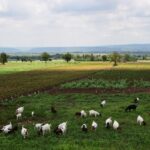Weeds are a persistent challenge for farmers, impacting crop yields and overall farm productivity. For South African farmers, effective weed management is crucial for maintaining healthy and productive crops. Here are the top five weeding techniques to keep your farm free of unwanted vegetation:
1. Manual Weeding
Description: Manual weeding involves physically removing weeds by hand or using simple tools such as hoes and trowels.
Benefits:
- Precise removal of weeds without damaging crops.
- Minimal environmental impact since no chemicals are used.
- Suitable for small farms and gardens.
Drawbacks:
- Labor-intensive and time-consuming.
- Not practical for large-scale operations.
Tips:
- Weed when the soil is moist, as weeds are easier to pull out.
- Regularly inspect fields to catch weeds early before they spread.
2. Mechanical Weeding
Description: Mechanical weeding uses machinery like cultivators, harrows, and tillers to uproot weeds.
Benefits:
- Efficient for large-scale farming.
- Reduces the need for chemical herbicides.
- Can be integrated with other farming activities.
Drawbacks:
- Initial investment in machinery can be high.
- May disturb the soil structure and harm beneficial organisms.
Tips:
- Adjust machinery settings to avoid damaging crops.
- Combine with manual weeding for areas machinery cannot reach.
3. Mulching
Description: Mulching involves covering the soil with organic or synthetic materials to suppress weed growth.
Benefits:
- Conserves soil moisture and improves soil health.
- Reduces weed germination by blocking sunlight.
- Biodegradable mulches add organic matter to the soil.
Drawbacks:
- Requires initial application effort.
- Some synthetic mulches can be costly and environmentally unfriendly.
Tips:
- Use organic mulches like straw, wood chips, or grass clippings for added soil benefits.
- Ensure mulch layer is thick enough (at least 5-10 cm) to effectively suppress weeds.
4. Cover Cropping
Description: Cover cropping involves planting certain crops that outcompete weeds for nutrients and sunlight.
Benefits:
- Enhances soil fertility and structure.
- Prevents soil erosion.
- Suppresses weed growth naturally.
Drawbacks:
- Requires careful planning and crop rotation.
- Cover crops need to be managed to prevent them from becoming weeds themselves.
Tips:
- Select cover crops suited to your climate and soil conditions (e.g., clover, rye, vetch).
- Terminate cover crops at the right time to avoid competition with main crops.
5. Chemical Weeding
Description: Chemical weeding uses herbicides to kill or inhibit weed growth.
Benefits:
- Effective for large areas and persistent weeds.
- Saves time and labor compared to manual and mechanical methods.
- Can be targeted to specific weed types.
Drawbacks:
- Potential environmental and health risks.
- Weeds can develop resistance to herbicides over time.
- Can be costly.
Tips:
- Use herbicides as part of an integrated weed management plan.
- Follow label instructions and safety guidelines strictly.
- Rotate herbicides with different modes of action to prevent resistance.
Effective weed management is essential for maintaining a productive and sustainable farm. By combining these top five weeding techniques—manual, mechanical, mulching, cover cropping, and chemical—you can create a comprehensive strategy tailored to your farm’s specific needs. Regular monitoring and adaptation of your weed management practices will ensure long-term success and a healthy crop yield.
For South African farmers, integrating these methods into your routine will not only control weeds but also enhance soil health, conserve resources, and ultimately improve your farm’s overall productivity.
Join 'Farmers Mag' WhatsApp Channel
Get the latest Farming news and tips delivered straight to your WhatsApp
CLICK HERE TO JOIN





